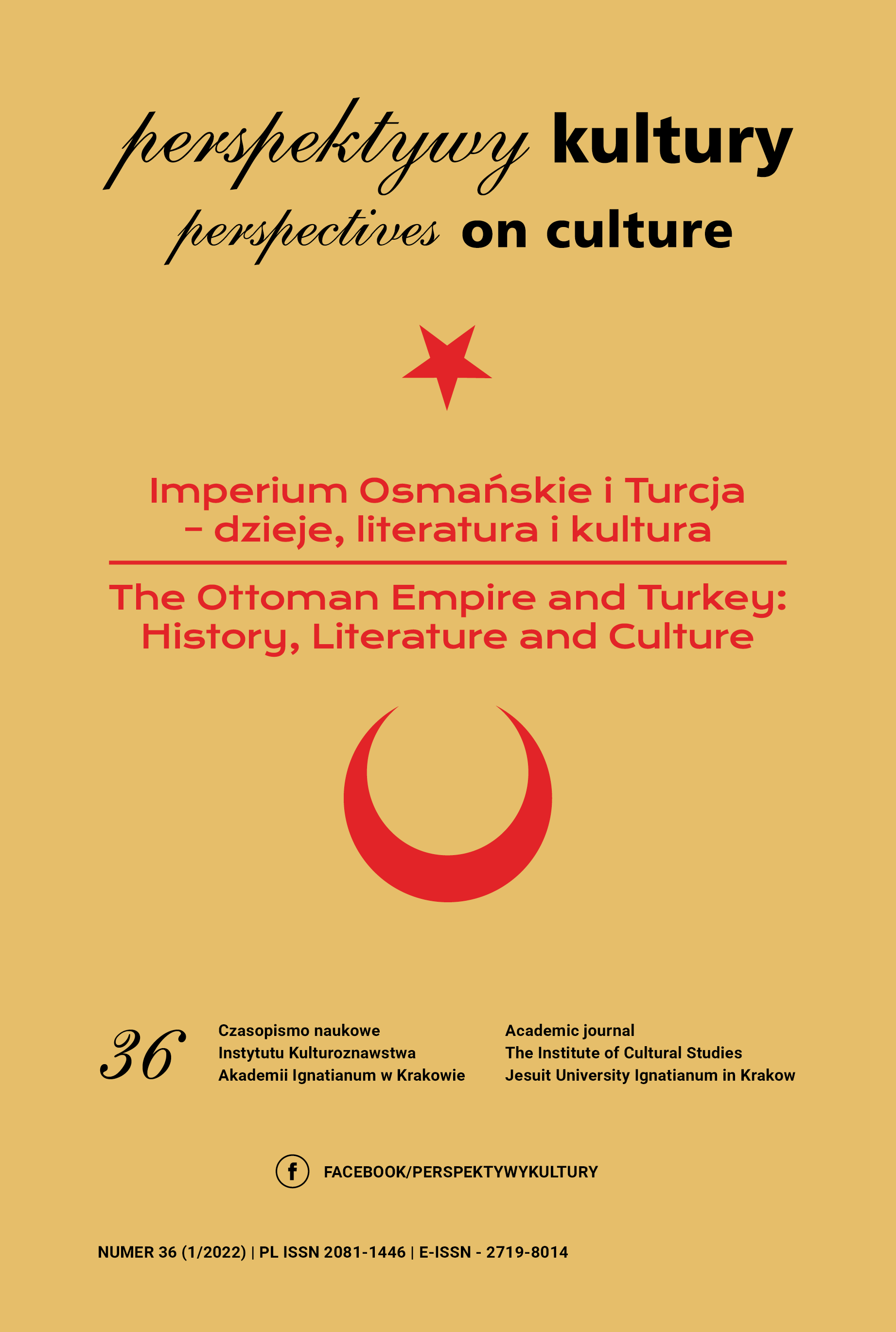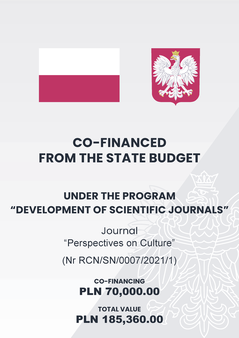Poland as the Bastion of Christianity and the Issue of a Union with the Orthodox Church
Abstract
When the Ottoman Turks began their conquest of further Balkan countries in the second half of the 14th century, they were opposed by Hungary, which came to known as the bastion of Christianity. The article analyses subsequent events of the 15th and 16th centuries when the term was first applied to the Kingdom of Poland. Poland’s greatest involvement in the war against the Muslims was during the reign of Ladislaus III of Hungary, who died in 1444 at the Battle of Varna. Under his successor, Kazimierz Jagiellończyk, Poland managed to avoid military conflict with Turkey, though it waged constant war with their allies, the Tatars. The first Turkish invasions of Poland followed the defeat in Bukovina in the autumn of 1497. In the ensuing decades, Poland was forced to renew truces with Turkey every few years, which drained the state’s coffers yet failed to protect it from the devastating Tartar invasions. After the fall of Hungary at the Battle of Mohács in 1526, Poland found itself on the front line, exposed to direct attack by the armies of the Padishah. The Holy See joined the defense against the Islamic threat, hoping to convince the Grand Duchy of Moscow to go to war with Turkey. Papal diplomacy was also centered on the followers of the Orthodox Church living within the borders of the Republic, which resulted in the Union of Brest in 1596.
References
Alef, F. (1961). Muscovy and the Council of Florence. Slavic Review, 20 (3), 389–401.
Anderson, M.S. (1998). The Origins of the Modern European State System, 1494–1618. London–New York: Longman.
Babinger, F. (1978). Mehmed the Conqueror and His Time. Princeton: Princeton University Press.
Baczkowski, K. (1997). Kallimachs Stelle in der Kulturgeschichte Polens. In: S. Füssel & J. Pirożyński (hrsg.), Der polnische Humanismus und die europäischen Sodalitäten. Akten des polnischdeutschen Symposions vom 15.–19. Mai 1996 im Collegium Maius der Universität Krakau. Wiesbaden: Harrassowitz, 73–90.
Bak, J.M. (2004). Crusading in Hungary in the Fifteenth Century. In: N. Housley (ed.), Crusading in the Fifteenth Century. Message and Impact. New York: Palgrave Macmillan, 116–127.
Bárány, A. (2012). The Expansions of the Kingdom of Hungary in the Middle Ages (1000–1490). In: N. Berend (ed.), The Expansion of Central Europe in the Middle Ages. London: Routledge: 352–357.
Bardach, J. (1969). Krewo i Lublin. Z problemów unii polsko-litewskiej. Kwartalnik Historyczny, 76 (3), 583–619.
Barwicka-Makuła, A. (2019). Od wrogości do przyjaźni. Habsburgowie austriaccy wobec Polski w latach 1587–1592. Katowice: Wydawnictwo Uniwersytetu Śląskiego.
Boratyński, L. (1903). Stefan Batory i plan ligi przeciwko Turkom 1576–1584. Kraków: Nakładem Akademii Umiejętności.
Cherniavsky, M. (1955). The Reception of the Council of Florence in Moscow. Church History, 24 (4), 347–359.
Chodynicki, K. (1934). Kościół prawosławny a Rzeczpospolita Polska. Zarys historyczny 1370–1632. Warszawa: Skład Główny Kasa im. Mianowskiego.
Domański, J. (1987). Filippo Buonaccorsi e la cultura filosofica del ‘400 in Polonia. In: G.C. Garfagnini (ed.), Callimaco Esperiente. Poeta e politico del ‘400. Convegno internazionale di studi (San Gimignano, 18–20 ottobre 1985). Institutio Nazionale di Studi sul Rinascimento. Atti di convegni, vol. 16. Firenze: Olschki, 25–43.
Dopierała, K. (1977). Liga antyturecka w planach Stefana Batorego. In: A. Czubiński (ed.), Polska – Niemcy – Europa. Studia z dziejów myśli politycznej i stosunków międzynarodowych. Poznań: Uniwersytet im. Adama Mickiewicza w Poznaniu, 101–110.
Dopierała, K. (2012). Problem zagrożenia tureckiego w czasie wojny polsko-moskiewskiej w latach 1579–1582. In: D. Quirini-Popławska (ed.), Antonio Possevino SJ (1533–1611). Życie i dzieło na tle epoki. Kraków: Wydawnictwo Akademii Ignatianum w Krakowie, Wydawnictwo WAM, 49–72.
Dubas-Urwanowicz, E. (2012). Między troską o losy Kościoła w Rzeczypospolitej a sympatią do Habsburgów. Hannibal z Kapui w Rzeczypospolitej w latach 1588–1591. In: M.R. Drozdowski, W. Walczak, & K. Wiszowata-Walczak (eds.), Od Kijowa do Rzymu. Z dziejów stosunków Rzeczypospolitej ze Stolicą Apostolską i Ukrainą. Białystok: Instytut Badań nad Dziedzictwem Kulturowym Europy, 431–450.
Dziubiński, A. (1965). Drogi handlowe polsko-tureckie w XVI stuleciu. Przegląd Historyczny, 56 (2), 232–259.
Dziubiński, A. (2005). Stosunki dyplomatyczne polsko-tureckie w latach 1500– 1572 w kontekście międzynarodowym. Wrocław: Wydawnictwo Uniwersytetu Wrocławskiego.
Fijałek, J. (1934). Los unii florenckiej w Wielkim Księstwie Litewskim za Kazimierza Jagiellończyka. In: Sprawozdanie z Czynności i Posiedzeń Polskiej Akademii Umiejętności. Nr 1. Styczeń. 8°. Posiedzenie Wydz. Histor.filozof. dnia 22 stycznia, vol. 39. Kraków: Nakładem Akademii Umiejętności, 21–24.
Geanakoplos, D.J. (1955). The Council of Florence (1438–1439) and the Problem of Union between the Greek and Latin Churches. Church History, 24 (4), 324–346.
Górka, O. (1933). Białogród i Kilia, a wyprawa r. 1497. In: Sprawozdania z Posiedzeń Towarzystwa Naukowego Warszawskiego. Wydz. II, vol. 25. Warszawa: Zakłady Graficzno-Introligatorskie J. Dziewulski
Graff, T. (2008). Zbigniew Oleśnicki i polski episkopat wobec unii personalnej z Królestwem Wegier w latach 1440–1444. In: J. Smolucha et al. eds., Historia vero testis temporum. Księga Jubileuszowa poświęcona Profesorowi Krzysztofowi Baczkowskiemu w 70. rocznicę urodzin. Kraków: Wydawnictwo Towarzystwa Naukowego Societas Vistulana; Instytut Historii Uniwersytetu Jagiellońskiego, 349–364.
Gregorowicz, D. (2019). Tiara w grze o koronę. Stolica Apostolska wobec wolnych elekcji w Rzeczypospolitej Obojga Narodów w drugiej połowie XVI wieku. Kraków: Polska Akademia Umiejętności.
Grygiel, J. (1992). Udział rycerstwa polskiego w walce z Turkami w czasach panowania Władysława Jagiełły i Zygmunta Luksemburskiego. Zeszyty Naukowe Uniwersytetu Jagiellońskiego. Prace Historyczne, 102, 75–85.
Gudziak, B. (1995). The Sixteenth-Century Muscovite Church and Patriarch Jeremiah II’s Journey to Muscovy, 1588–1589. Some Comments concerning the Historiography and Sources. Harvard Ukrainian Studies, 19, 200–225.
Graff, T. (2008). Episkopat monarchii jagiellońskiej w dobie soborów powszechnych XV wieku. Kraków: Wydawnictwo Towarzystwa Naukowego Societas.
Graff, T. (2017). The Catholic Church in Poland and King Władysław III’s Crusade Against the Turks. In: J. Smolucha et al., Holy War in Late Medieval and Early Modern East-Central Europe. Kraków: Wydawnictwo Naukowe Akademii Ignatianum w Krakowie, 95–107.
Halecki, O. (1920). Dzieje Unii Jagiellońskiej. Vol. 2. Kraków: Akademia Umiejętności.
Halecki, O. (1958). From Florence to Brest (1439–1596). Rome: Sacrum Poloniae Millennium; New York: Fordham University Press.
Hankins, J. (1995). Renaissance Crusaders. Humanist Crusade Literature in the Age of Mehmed II. Dumbarton Oaks, 49, 111–207.
Housley, N. (2014). Christendom’s Bulwark. Croatian Identity and the Response to the Ottoman Advance, Fifteenth to Sixteenth Centuries. Transactions of the Royal Historical Society, 24, 149–164.
Inalcik, H. (1954). Ottoman Methods of Conquest. Studia Islamica, 2, 103–129.
Ivanov, S.A. (2016). The Second Rome as Seen by the Third. Russian Debates on ‘the Byzantine legacy’. In: P. Marciniak & D.C. Smythe (eds.), The Reception of Byzantium in European Culture since 1500. London–New York: Routledge, 55–80.
Jefferson, J. (2012). The Holy Wars of King Wladislas and Sultan Murad. The Ottoman-Christian Conflict from 1438–1444. Leiden–Boston: Brill.
Joannis Dlugossii (2001). Joannis Dlugossii Annales seu Cronicae incliti Regni Poloniae. Lib. 11–12, 1431–1444. K. Baczkowski et al. (eds.). Varsaviae: Wydawnictwo Naukowe PWN.
Joannis Dlugossii (2003). Joannis Dlugossii Annales seu Cronicae incliti Regni Poloniae. Lib. 12, 1445–1461. K. Baczkowski et al. (eds.). Cracoviae: Wydawnictwo Naukowe PWN.
Knoll, W. (1974). Poland as “Antemurale Christianitatis” in the Late Middle Ages. The Catholic Historical Review, 60 (3), 397–398.
Kołodziejczyk, D. (2000). Ottoman-Polish Diplomatic Relations (15th – 18th Century). An Annotated Edition of ‘ahdnames and other Documents. Leiden– Boston: Brill.
Królikowska, N. (2013). Sovereignty and Subordination in Crimean-Ottoman Relations. In: G. Kármán & L. Kunčević (eds.), The European Tributary States of the Ottoman Empire in the Sixteenth and Seventeenth Centuries. Leiden–Boston: Brill, 43–65.
Meuthen, E. (1983). Der Fall von Konstantinopel und der Lateinische Westen. Historische Zeitschrift, 237 (1), 1–35.
Nagielski, M. (2013). Rywalizacja Rzeczypospolitej z Państwem Moskiewskim o dominację w Europie Środkowo-Wschodniej w XVI–XVII. Sensus Historiae, 11 (2), 87–115.
Oakley, S.P. (1992). War and Peace in the Baltic 1560–1790. London–New York: Routledge.
Obara-Pawłowska, A. (2021). Pamięć o bitwie pod Warną w polskich źródłach historiograficznych do końca XVI wieku. Zeszyty Naukowe Uniwersytetu Jagiellońskiego. Prace Historyczne, 148 (3), 463–486.
Olejnik, K. (1996). Władysław III Warneńczyk. Szczecin: Wydawnictwo Archiwum Państwowego „Dokument”.
Pálosfalvi, T. (2018). From Nicopolis to Mohács. A History of Ottoman-Hungarian Warfare, 1389–1526. Leiden–Boston: Brill.
Panaite, V. (2019). Ottoman law of war and peace. The Ottoman Empire and its tribute-payers from the north of the Danube. Leiden-Boston: Brill.
Papademetriou, T. (2015). Render unto the Sultan: Power, Authority, and the Greek Orthodox Church in the Early Ottoman Centuries. Oxford: Oxford University Press.
Philippides, M. & Hanak, W.K. (2018). Cardinal Isidore, c. 1390–1462. A Late Byzantine Scholar, Warlord, and Prelate. London–New York: Routledge.
Plewczyński, M. (2002). Wojny Jagiellonów z wschodnimi i południowymi sąsiadami Królestwa Polskiego w XV wieku. Siedlce: Wydawnictwo Akademii Podlaskiej.
Podskalsky, G. (1989). Die Einstellung des ökumenischen Patriarchen Jeremias II zur Erhebung des Moskauer Patriarchats (1589). Orientalia Christiana Periodica, 55, 421–437.
Poe, M. (2001). Moscow, the Third Rome. The Origins and Transformations of a “Pivotal Moment”. Jahrbücher für Geschichte Osteuropas. Neue Folge, 49 (3), 412–419.
Setton, K.M. (1976). The Papacy and the Levant (1204–1571). Vol. 1. Philadelphia: American Philosophical Society.
Setton, K.M. (1978). The Papacy and the Levant (1204–1571). Vol. 2. Philadelphia: American Philosophical Society.
Shaw, S.J. (1976). History of the Ottoman Empire and Modern Turkey. Vol. 1. Cambridge: Cambridge University Press.
Smołucha, J. (1995). Między Warną a Mohaczem. Zagrożenie tureckie w Polsce w świetle wybranych traktatów. Studia Historyczne, 37 (4), 459–480.
Smołucha, J. (1999). Papiestwo a Polska w latach 1484–1526. Kontakty dyplomatyczne na tle zagrożenia tureckiego. Kraków: Societas Vistulana.
Smołucha, J. (2012). Uwagi na temat kwestii tureckiej w działalności dyplomatycznej i naukowej ojca Antonia Possevina. In: D. Quirini-Popławska (ed.), Antonio Possevino SJ (1533–1611). Życie i dzieło na tle epoki. Kraków: Wydawnictwo Akademii Ignatianum w Krakowie, Wydawnictwo WAM, 549–566.
Smołucha, J. (2016). Próby wciągnięcia przez Stolicę Apostolską Polski i Czech do udziału w krucjacie antytureckiej w połowie XV wieku. In: T. Ciesielski & W. Iwańczak (eds.), Czechy i Polska między Wschodem i Zachodem – średniowiecze i wczesna epoka nowożytna. Warszawa: Wydawnictwo DiG, 143–158.
Smołucha, J. (2021). Idea jedności słowiańskiej w działalności dyplomatycznej w Europie Środkowo-Wschodniej nuncjusza papieskiego Aleksandra Komulovića w latach 1594–1597. Kultura Słowian. Rocznik Komisji Kultury Słowian Polskiej Akademii Umiejętności, 17, 33–80.
Spieralski, Z. (1963). Po klęsce bukowińskiej 1497 roku. Pierwsze najazdy Turków na Polskę. Studia i Materiały do Historii Wojskowości, 9 (1), 45–58.
Srodecki, P. (2016). Władysław III and the Polish-Hungarian Bulwark topoi against the Background of the Ottoman Threat in the 15th Century. In: D. Bagi. G. Barabás, & Z. Máté (eds.), Hungaro-Polonica. Young Scholars on Medieval Polish-Hungarian Relations. Pécs: Történészcéh Egyesület, 327–356.
Stachoń, B. (1930). Polityka Polski wobec Turcyi i akcyi antytureckiej w wieku XV do utraty Kilii i Białogrodu (1484). Lwów: Towarzystwo Naukowe; Drukarnia Uniwersytetu Jagiellońskiego pod Zarządem J. Filipowskiego.
Tazbir, J. (1984). Od antemurale do przedmurza, dzieje terminu. Odrodzenie i Reformacja w Polsce, 29, 1548–1567.
Thumser, M. (2000). Eine Neue Aufgabe im Heidenkampf? Pläne mit dem Deutschen Orden als Vorposten gegen die Türken. In: B. Guthmüller & W. Kühlmann (hrsg.), Europa und die Türken in der Renaissance. Tübingen: Niemeyer Publ., 139–176.
Toumanoff, C. (1955). Moscow the Third Rome. Genesis and Significance of a Politico-Religious Idea. The Catholic Historical Review, 40 (4), 411–440.
Vogüé, E.M. de (1879). De Byzance à Moscou. Les voyages d’un patriarche. Revue des deux mondes, 32, 5–35.
Copyright (c) 2022 Jesuit University Ignatianum in Krakow

This work is licensed under a Creative Commons Attribution 4.0 International License.
Autor, zgłaszając swój artykuł, wyraża zgodę na korzystanie przez Wydawnictwo Uniwersystet Ignatianum z utworu na następujących polach eksploatacji:
- utrwalania utworu w formie papierowej, a także na nośniku cyfrowym lub magnetycznym;
- zwielokrotnienia utworu dowolną techniką, bez ograniczenia ilości wydań i liczby egzemplarzy;
- rozpowszechniania utworu i jego zwielokrotnionych egzemplarzy na jakimkolwiek nośniku, w tym wprowadzenia do obrotu, sprzedaży, użyczenia, najmu;
- wprowadzenia utworu do pamięci komputera;
- rozpowszechniania utworu w sieciach informatycznych, w tym w sieci Internet;
- publicznego wykonania, wystawienia, wyświetlenia, odtworzenia oraz nadawania i reemitowania, a także publicznego udostępniania utworu w taki sposób, aby każdy mógł mieć do niego dostęp w miejscu i czasie przez siebie wybranym.
Wydawca zobowiązuje się szanować osobiste prawa autorskie do utworu.






